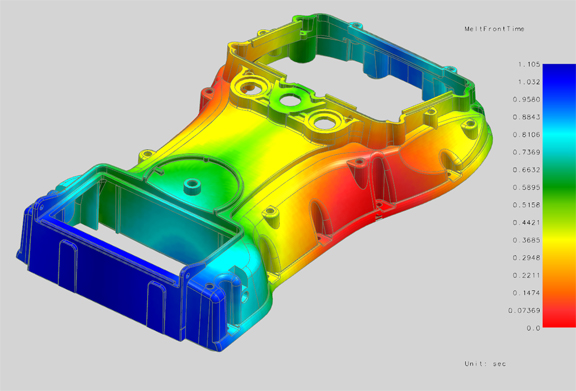Latest News
December 17, 2012
In 2008, when Autodesk got its hands on Moldflow in an acquisition, it gained a huge advantage over rivals CAD developers. The ability to simulate the injection-molding process for molded plastic products brought design (CAD) and manufacturing (CAM) closer than before. The software is still available as a standalone program, rebranded as Autodesk Moldflow. But it’s also tightly integrated with Autodesk’s primary 3D mechanical design software, Autodesk Inventor, though a plug-in called Moldflow Adviser.
This week, Siemens PLM Software’s NX program gets a similar treatment with the integration of EasyFill Mold Analysis. The technology came from CoreTech System, makers of Moldex3D, a plastic simulation package.
“NX EasyFill Analysis enables designers to easily check potential manufacturing defects without leaving the NX design environment,” according to the company. “It helps users tackle significant molding issues more efficiently to optimize gate number/locations, material selection, or process conditions. Additionally, Moldex3D provides more advanced capabilities in its ‘eDesignSYNC for NX’ to support packing, cooling, fiber orientation, and warpage predictions. It allows NX users to visualize more critical molding factors and evaluate the results, such as sink marks, overpacking, or thermal displacement and part shrinkage.”
Robin Wei, Moldex3D’s product manager, split his time between Chupei City, Taiwan, where CoreTech is headquartered, and Northville, Michigan, where the Moldex3D sales & support team is. This week, he happens to be in the States, poised to address my questions when I called him up.
Though NX has a robust collection of stress analysis and simulation tools, EasyFill is the first-ever plastic mold simulation tool for the software, said Wei. “We delivered our [Moldex3D] solver and the API to Siemens developers,” explained Wei. “So NX developers were able to integrate those solvers into their own API ... It’s free. It’s a trial version, but [users] can use the basic features. If they want to use the more advanced features, however, they’ll have to buy a license.”
Through other plug-ins available from the company, you may also deploy Moldex3D with Dassault Systemes’ CATIA, SolidWorks, or PTC’s Creo, all competing products of Siemens’ NX.
Moldex3D also offers an on-demand solution, where you may use the processing power of remote servers to speed up the mold simulation process. Branded “Moldex3D Cloud Services Solution,” the solution uses “the power of high-performance computing (HPC) capability for users to enable the plastic design verification and optimization on the cloud. Now, two solutions are available on market: Moldex3D Public Cloud Services is exclusively in North America and Moldex3D Private Cloud Solution is marketed worldwide,” the company explains. The on-demand application is available for test-driving for free.
Subscribe to our FREE magazine, FREE email newsletters or both!
Latest News
About the Author
Kenneth Wong is Digital Engineering’s resident blogger and senior editor. Email him at [email protected] or share your thoughts on this article at digitaleng.news/facebook.
Follow DE






